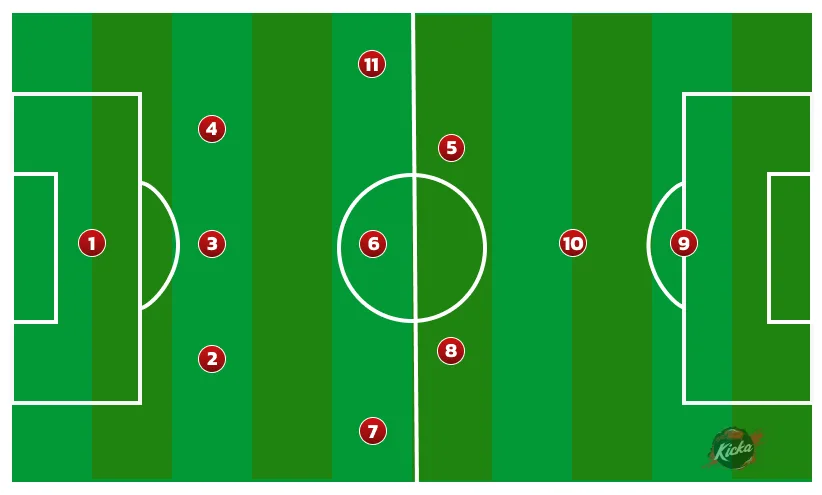Carlos Bilardo started the 3-5-1-1 formation with Argentina in 1986, who later won Argentina’s second World Cup. The 3-5-1-1 is a variation of the traditional 4-4-2 formation known for its flexibility and ability to control the midfield. The formation consists of three central defenders, five midfielders, one attacking midfielder, and one lone striker.
The origin of the 3-5-1-1 formation can be traced back to Italian football in the 1990s. Italian teams, known for their defensive solidity, began experimenting with different formations to gain an advantage over their opponents. The 3-5-1-1 formation was born from this experimentation and quickly spread to other leagues worldwide.
In terms of structure and positioning, the 3-5-1-1 formation is characterized by a strong defensive base with three central defenders forming a solid backline. The five midfielders provide defensively and offensively support, with the wing-backs providing width on the flanks. The attacking midfielder plays behind the lone striker, acting as a playmaker and linking the midfield with the attack.

Understanding the Roles and Responsibilities of Players in the 3-5-1-1 Formation
In the 3-5-1-1 formation, each player has specific roles and responsibilities contributing to the team’s overall success. Let’s break down each player’s role:
1. Central Defenders: The three central defenders maintain a solid defensive line and prevent the opposition from scoring. They must communicate effectively with each other to ensure they stay organized and cover any gaps in defense. They should also be comfortable on the ball and capable of initiating attacks from the back.
2. Wing-backs: The wing-backs are crucial in providing width to the team’s attack. They are responsible for overlapping the midfielders and delivering crosses into the box. Defensively, they must track back and provide cover for the central defenders.
3. Central Midfielders: The three central midfielders are the team’s engine room. They control the midfield, win back possession, and distribute the ball to the attacking players. They must have good passing ability, vision, and defensive awareness.
4. Attacking Midfielder: The team’s creative force is the attacking midfielder. They are responsible for linking the midfield with the attack, creating scoring opportunities, and providing assists. They must have excellent vision and passing ability and be comfortable in tight spaces.
5. Lone Striker: The lone striker leads the line and scores goals. They must be strong, agile, and have good finishing ability. They should also be capable of holding up play and bringing other players into the game.
Communication and teamwork are essential in executing the 3-5-1-1 formation effectively. Players must constantly communicate with each other to ensure they are in the correct positions and make quick decisions on and off the ball. Teamwork is crucial in attacking and defending situations, as players must work together to create scoring opportunities and prevent the opposition from scoring.

Mastering Defensive Strategies in the 3-5-1-1 Formation
Effective defending is crucial in any formation, and the 3-5-1-1 is no exception. Here are some tips for mastering defensive strategies in this formation:
1. Maintain Shape: Players must maintain their positions and shape when defending in a 3-5-1-1 formation. The three central defenders should stay compact and cover each other to prevent gaps from opening up. The wing-backs should track back quickly to provide cover on the flanks.
2. Discipline: Discipline is key in defending. Players must be disciplined in their positioning and not get drawn out of position. The central midfielders should cover the central defenders and track back to help defend when necessary.
3. Pressing: Effective pressing is crucial in the 3-5-1-1 formation. The attacking midfielder should lead the press, putting pressure on the opposition’s midfielders and forcing them into making mistakes. The lone striker should also press the opposition’s defenders to prevent them from playing out from the back.
Attacking Strategies and Techniques in the 3-5-1-1 Formation
Attacking Strategies and Techniques in the 3-5-1-1 Formation
Description
Overlapping Fullbacks
The fullbacks push forward and overlap with the wingers to create width and overload the opposition’s defense.
Central Overload
The central midfielder pushes forward to create a numerical advantage in the center of the pitch and create chances for the striker.
False 9
The striker drops deep, creating space for the attacking midfielder to run into and create chances.
Quick Transitions
The team looks to quickly transition from defense to attack by playing long balls to the striker or using the pace of the wingers to counter-attack.
High Press
The team aims to win the ball high up the pitch and quickly create chances before the opposition can recover.
The 3-5-1-1 formation offers several attacking opportunities. Here are some tips for creating scoring opportunities in this formation:
1. Utilise the Attacking Midfielder: The attacking midfielder is the key playmaker in this formation. They should find pockets of space between the opposition’s midfield and defense, receive the ball, and create scoring opportunities for themselves and their teammates.
2. Lone Striker Movement: The lone striker should be constantly on the move, making runs into the channels and dragging defenders out of position. This movement creates space for the attacking midfielder and other midfielders to exploit.
3. Overlapping Wing-backs: The wing-backs should provide width to the team’s attack by overlapping the midfielders and delivering crosses into the box. This creates additional attacking options and puts pressure on the opposition’s defense.
Transitioning from Defence to Offence in the 3-5-1-1 Formation
Quick and efficient transitions are crucial in modern football, and the 3-5-1-1 formation allows for effective counter-attacking opportunities. Here are some tips for transitioning from defense to offense in this formation:
1. Quick Passing: Players should look to quickly play quick, one-touch passes to transition from defense to offense. This catches the opposition and allows the team to exploit open spaces.
2. Utilise the Attacking Midfielder: The attacking midfielder should be the focal point of the team’s counter-attacks. They should look to receive the ball quickly and play forward passes to release the lone striker or other attacking players.
3. Maintain Possession: While counter-attacking is essential, it is also crucial to maintain possession when necessary. Players should be comfortable on the ball and look to retain possession without immediate scoring opportunities.
Building Team Chemistry and Communication in the 3-5-1-1 Formation
Team chemistry and communication are vital in executing the 3-5-1-1 formation effectively. Here are some tips for building a cohesive team and effective communication:
1. Team Bonding: Building team chemistry starts off the field. Organize team-building activities and encourage players to spend time together outside training sessions. This helps build trust and understanding between teammates.
2. Effective Communication: Encourage players to communicate with each other on and off the field. This includes verbal communication, hand signals, and body language. Effective communication helps players stay organized, make quick decisions, and execute game plans effectively.
3. Practice Set Plays: Set plays such as free kicks, corners, and throw-ins require effective communication and coordination between players. Practice these set plays regularly to ensure everyone knows their roles and responsibilities.
Training and Conditioning for Players in the 3-5-1-1 Formation
Training and conditioning are crucial for players in the 3-5-1-1 formation to execute their roles effectively. Here are some specific training and conditioning exercises for players in this formation:
1. Position-Specific Training: Each player should undergo position-specific training to improve their skills and understanding of their role in the formation. This includes drills focusing on passing, shooting, defending, and positioning.
2. Endurance Training: The 3-5-1-1 formation requires players to cover many defensive and offensive ground. Endurance training, such as interval running and high-intensity interval training (HIIT), helps players improve their stamina and fitness levels.
3. Tactical Drills: Incorporate tactical drills that simulate game situations and focus on the specific movements and patterns of play in the 3-5-1-1 formation. This helps players better understand their roles and responsibilities and improves their decision-making abilities.
Analyzing Opponents and Adjusting Strategies in the 3-5-1-1 Formation
Analyzing opponents and adjusting strategies accordingly is crucial in the 3-5-1-1 formation. Here are some tips for identifying opponent weaknesses and exploiting them:
1. Scout Opponents: Study your opponent’s previous matches and identify their strengths and weaknesses. Look for patterns of play, key players, and areas where they are vulnerable.
2. Adjust Formation: Based on your analysis of the opponents, consider adjusting your formation to exploit their weaknesses. This could involve making positional changes or altering the roles and responsibilities of certain players.
3. Set Plays: Set plays can be an effective way to exploit opponent weaknesses. Identify areas where the opponents are vulnerable, such as defending corners or free kicks, and develop set plays to take advantage of these situations.
Common Mistakes to Avoid in the 3-5-1-1 Formation
While the 3-5-1-1 formation offers many advantages, there are also common mistakes that teams and players make. Here are some tips for avoiding these mistakes and improving performance:
1. Lack of Communication: Effective communication is crucial in this formation but is also a common area where teams struggle. Encourage players to communicate with each other constantly and work on improving communication skills during training sessions.
2. Overcommitting in Attack: While the 3-5-1-1 formation offers attacking opportunities, it is important not to overcommit in attack and leave the team vulnerable to counter-attacks. Players should be aware of their defensive responsibilities and not neglect their defensive duties.
3. Lack of Flexibility: The 3-5-1-1 formation requires players to be flexible and adapt to different situations. Players should be comfortable playing in various positions and be willing to adjust their roles and responsibilities based on the game’s demands.
Teams that have mastered the 3-5-1-1 Formation
Several successful teams have effectively used the 3-5-1-1 formation. One notable example is Antonio Conte’s Chelsea team during the 2016-2017 season. Conte implemented the formation, and Chelsea won the Premier League title with a record-breaking 30 wins out of 38 matches.
These success stories highlight the effectiveness of the 3-5-1-1 formation when executed properly. Teams that have mastered this formation have shown that it can be a potent system that allows for both defensive solidity and attacking flair.
The 3-5-1-1 formation offers a flexible and effective tactical system for teams looking to control the midfield and create scoring opportunities. Understanding the roles and responsibilities of each player, mastering defensive and attacking strategies, building team chemistry, and analyzing opponents are all crucial aspects of executing this formation effectively.
While there are common mistakes to avoid, teams can learn from success stories and examples of teams that have mastered the 3-5-1-1 formation. With practice, training, and a commitment to teamwork and communication, teams and players can work towards mastering this formation and achieving success on the field. So, why not give the 3-5-1-1 formation a try and see how it can elevate your team’s performance?
If you are a football enthusiast looking to explore different formations, this article on the 3-5-1-1 formation is intriguing. This tactical setup offers a unique balance between defensive solidity and attacking prowess. It provides valuable insights and analysis on how teams can effectively implement the 3-5-1-1 formation to gain an edge on the pitch.






